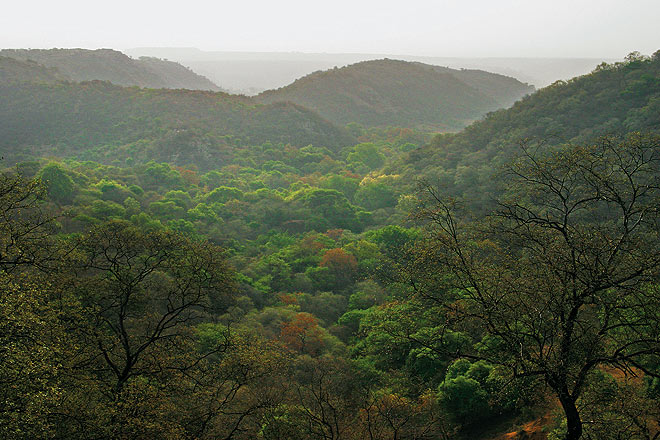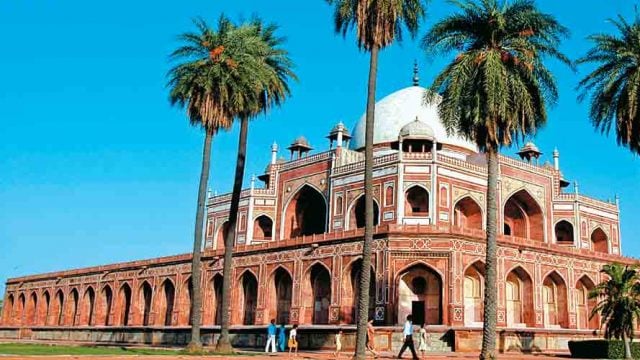Nothing prepares you for the first view of Mangarbani. There’s the Gurgaon-Faridabad toll road, your standard highway

In the middle of this nowhere, Pradip Krishen, author of Trees of Delhi who I am accompanying, stops the car. We walk for about ten minutes, winding our way past rocks hugged by stunted plants, between trees twisted by hot dry winds. It is eight o’clock on a morning in late March and it already feels like summer. And then, suddenly, we arrive at the lip of a cliff. The ground drops away and so does my jaw. Spread out below us is a deep wooded valley, densely yet delicately green, the expanse of its tree canopy broken only by the whitewashed domed tower of a small shrine in the distance. Besides the shrine, the only other sign of human presence is a boundary pillar on the far end of the valley. That’s it; the rest is undisturbed forest. The only sound is the plaintive call of peafowl, the only movement their ponderous glide from one tree to another. Oh, there’s also the racket of parakeets arrowing across the sky. Some grasses waving as the breeze catches the outcrop of rocks below our feet. Everything else is still. We could be in the middle of Sariska National Park except that we are not. We’re in Delhi NCR, twenty minutes away from the wall-to-wall carpeting of tarmac-glass-concrete-stone, twenty minutes from traffic jams, crowds, noise, dust and smoke. It feels like we’ve landed on a different planet.
What’s so special about Mangarbani? It’s not as if Delhi lacks large green spaces. There is the Ridge, the northern-most spur of the Aravali range, which stretches all the way to Rajasthan. Those wooded parts along its hilly spine that survive — after encroachments by the army, ashrams of sundry sants, shopping malls, street-widening and other forms of land grab have carved out and consumed big chunks of its area — are cool green havens. Along with the city’s parks and gardens, the Ridge is a major draw for morning walkers, laughter clubs and lovers looking for solitude. But from the ecological point of view, it is seriously compromised. A lot of the Ridge has been spruced up for human use, the undergrowth cleared and exotic species planted. Among these imports, the most pernicious has been vilayati keekar (Prosopis juliflora) which has established itself at the expense of indigenous tree species and the life forms they support. Because it is hardy and propagates easily, vilayati keekar has been a favourite of forest departments looking for a quick-fix for greening India since colonial times. So in most large green areas in Delhi and its environs today, it dominates over native species, to the detriment of local biodiversity.
Mangarbani has managed to remain remarkably free of the vilayati keekar curse. Even more miraculous, it has not undergone any human interference or exploitation for several hundred years. The surrounding villages have protected the grove as sacred to the memory of Gudariya Baba, a hermit whose shrine stands at the base of the valley. They believe that anyone who cuts wood or grazes their animals in this hundred-hectare forest invites the Baba’s wrath and retribution. So Mangarbani stands out in the Delhi region for being an unspoiled old growth forest of a kind unique to the Aravalis, a startling vision of what these ancient hills would look like if they were protected from biotic pressure.

And what a vision it is! The top of the valley and its steep sides are thickly covered with dhau (Anogeissus pendula), a medium-sized tree with pretty leaves that go from pale green to purple brown. Such a profusion of dhau is typical of the climax vegetation of some tropical dry deciduous forests. According to Kri-shen, whose book brought Mangarbani to the notice of a wider public, the tree used to be found all over the Ridge but is now in danger of disappearing in Delhi. Two other beautiful trees found in such forests that have vanished altogether from the Ridge — kala siris (Albizia odoratissima) and salai (Boswellia serrata) with its fragrant resin — survive only in Mangarbani in the Delhi region. The valley includes some dry and sandy patches where plants typical of arid regions: trees like kareel (Capparis decidua) — the kair of the famous Rajasthani vegetable dish kair-sangri — and roheda (Tecomella undulata) with its flamboyant orange flowers can be found. The moist valley floor is shadowed by tall kaim (Mitragyna parvifolia) — the original kadamb of Krishna’s Brindavan — and kanju (Holoptelea integrifolia) with its fruit encased in translucent papery discs. Along with these are the more common trees of the Ridge: ronjh (Acacia leucophloea), bistendu (Diospyros cordifolia), hingot (Balanites roxburghi) and doodhi (Wrightia tinctoria). In this season, doodhi ki bel (Vallaris solanacea) is laden with sweet-smelling creamy flowers; its perfume escorts us down to Gudariya Baba’s shrine.
On the path to the shrine is a nasty surprise. There is a temple, a large building with a courtyard and pond, which is being expanded to double its size. The land has already been cleared of its vegetation. The temple is the site of an annual fair and other events, and the crowds that descended on it most recently have left behind smelly heaps of dirty Styrofoam plates. Although the temple’s growing precincts pose a problem in this pristine area, there is an even bigger issue at stake, one that threatens the very existence of Mangarbani.
Mangarbani and its surrounding land used to be the commons of Mangar, Bandhwari and Baliawas villages. In the mid-1980s, collective ownership of the commons was partitioned and owners of agricultural land were given titles to proportionate amount of land in the commons. Once the commons were privatized, many villagers sold their titles to real estate developers and speculators who have fenced and walled in their plots, preparatory to clearing and building on them. This activity is so far confined to the area surrounding Mangarbani but may soon encroach into the forest as well if the real estate lobby in the Haryana government has its way. The draft Development Plan for Mangar zones the area for commercial and residential use, a designation that is a death sentence for Mangarbani. This is in clear violation of the Supreme Court order that such densely wooded areas, regardless of ownership, be notified as forests and protected accordingly. There is an active campaign to save Mangarbani by spreading awareness of this beautiful bit of biodiversity and by pressurizing the government to fulfil its environmental mandate.

Saving Mangarbani requires strengthening its legal status as a protected area and enforcing the law. It also means that about five hundred hectares around the forest need to be regulated as a buffer zone with restricted activities, especially a ban on construction and water-intensive land use. The area forms the watershed of a seasonal stream that runs through Mangarbani and helps create this unique habitat, while also recharging groundwater in the area and supplying water to the Dhauj lake nearby. Haryana has already done plenty to deplete its scarce water sources; destroying this particular catchment will be another act of development folly. Most of the buffer has scattered and stunted trees that are indigenous to the Aravalis. Although vilayati keekar has spread here, dhau, ronjh, palash (Butea monosperma), amaltas (Cassia fistula) and other natives still predominate. There is great potential for restoring the original forest that existed here, for giving the nilgai and jackals an undivided landscape to roam, and recreating a habitat for indigenous flora and fauna in a geologically dramatic setting. The challenge for the Haryana government is to sort out and settle property rights in the area and to make villagers, who have protected this area for centuries, partners in future conservation. Only continued public pressure will compel the government to do the right thing by Mangarbani.
As we walk through Mangarbani, I feel a wave of gratitude towards the villagers who have kept this jewel of a landscape safe through the centuries. When most of the Aravalis — the forests and the very rocks — have been felled and mined, Mangarbani has survived. The loss of this habitat will be an ecological tragedy, one that will leave Delhi NCR immeasurably poorer. In the future too, Gudariya Baba’s word must be honoured and upheld.
Gurgaon Faridabad toll road
Mangarbani
Leave a Reply
You must be logged in to post a comment.





